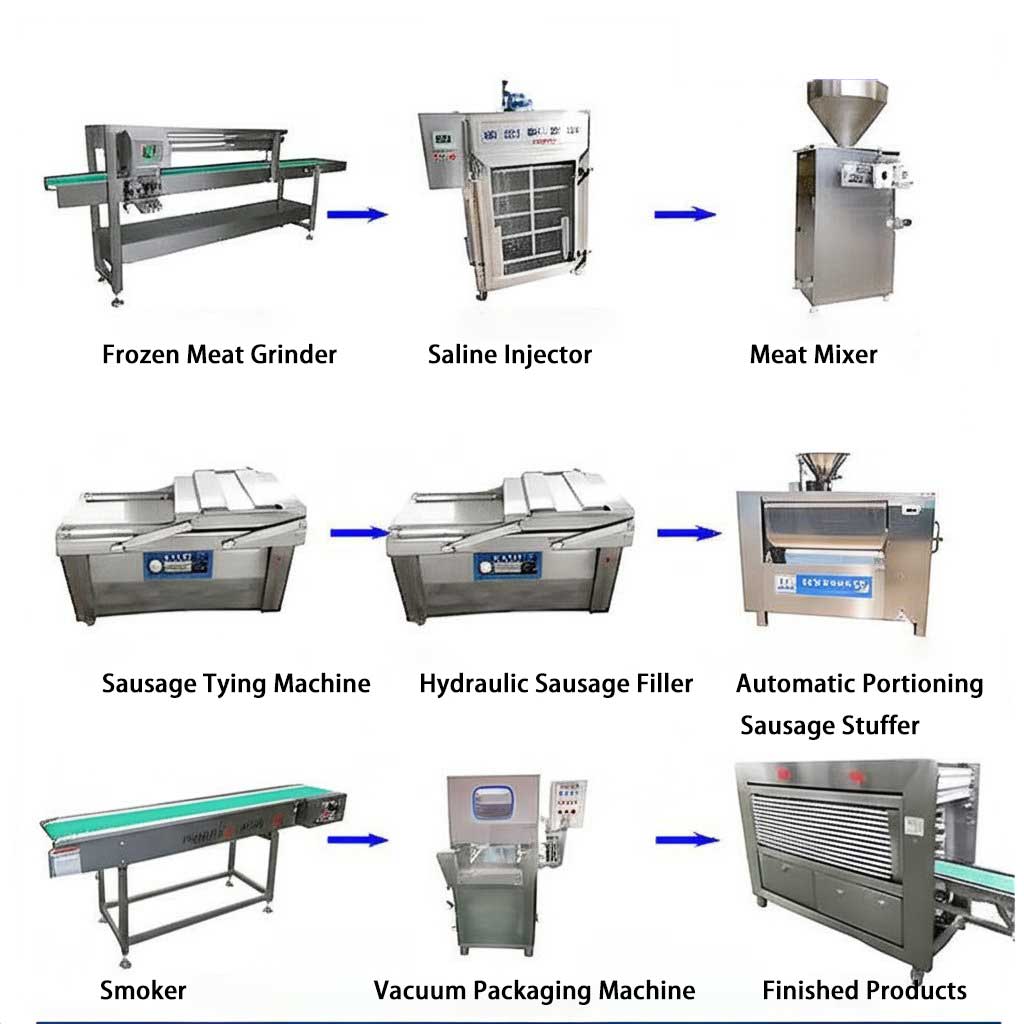Sausage processing production line
Description
Introduction to Our Sausage Processing Production Line
The sausage processing production line is an intricate system designed to efficiently produce high-quality sausages. This comprehensive system encompasses a variety of specialized equipment that streamlines every stage of the sausage-making process, from meat preparation to final packaging. Below, we will delve deeper into each component of the production line, outlining its functions and importance in ensuring a seamless workflow.

1. Frozen Meat Grinder: The Foundation of Quality
The first step in the sausage-making process often begins with the Frozen Meat Grinder. This machine is crucial for breaking down large cuts of meat into smaller, more manageable pieces. Designed to handle frozen meat, it maintains the integrity of the meat fibers, ensuring a consistent texture in the final product. Here’s why a reputable grinder is vital:
- High Efficiency: Processing frozen meat significantly reduces waste and ensures bulk production.
- Product Quality: The grinder preserves flavor and moisture, leading to superior sausage quality.
- Versatility: Can handle various types of meat, making it suitable for different sausage recipes.
2. Saline Injector: Enhancing Flavor and Preservation
Once the meat is ground, it’s time to enhance its flavor and longevity using the Saline Injector. This machine injects a saline solution into the meat, which can include a blend of water, salt, and spices. The main benefits are:
- Flavor Infusion: Ensures that the meat is well-seasoned, resulting in a more flavorful sausage.
- Preservation: The brining process helps in preserving the meat, extending its shelf life.
- Texture Improvement: Creates a juicy and tender end product that delights consumers.
3. Stuffing Mixer: Perfecting the Blend
After brining, the next step is mixing. The Stuffing Mixer or Meat Mixer combines ground meat, seasonings, and fillers (if used) to create a consistent stuffing mixture. Key features include:
- Uniform Mixture: Ensures that all ingredients are evenly distributed for consistency in flavor and texture.
- Increased Production Speed: Automated mixing capabilities save time and labor costs.
- Batch Control: Allows for customization of recipes while maintaining portion control.
4. Sausage Tying Machine: Precision and Efficiency
As the mixture is prepared, it needs to be encased properly. The Sausage Tying Machine, also known as the Clipping Machine, is essential for sealing sausages tightly. This stage offers several advantages:
- Reliable Sealing: Ensures that each sausage is hermetically sealed, preventing leakage and spoilage.
- High Throughput: Capable of processing thousands of sausages per hour, enhancing productivity.
- Customization Options: Different tying techniques can be implemented based on sausage type.
5. Hydraulic Sausage Filler: The Heart of Production
The Hydraulic Sausage Filler plays a pivotal role in the sausage-making process. This device is responsible for stuffing the meat mixture into casings with precision. Its features include:
- Controlled Filling: The hydraulic system allows for consistent filling without air pockets, resulting in a uniform product.
- Adaptable: Suitable for various casing types, including natural and synthetic casings.
- User-Friendly: Most machines offer easy operation, reducing the learning curve for new operators.
6. Automatic Quantitative Sausage Filler: Precision and Portion Control
For production lines seeking automation, the Automatic Quantitative Sausage Filler is the ideal solution. It streamlines the filling process by providing exact quantities of stuffing per casing:
- Efficiency: Automates the filling process, saving labor and reducing human error.
- Consistent Portions: Ensures that each sausage is filled with the same amount, promoting uniformity in size and weight.
- Integration Capability: Easily integrates with other machinery in the production line.
7. Smokehouse: Adding Flavor and Preservation
After the sausages are filled and tied, the next step often involves smoking. The Smokehouse or Smoker provides a unique aroma and flavor, critical for many types of sausages. This process offers several benefits:
- Flavor Enhancement: The smoking process imparts rich flavors, taking the product to the next level.
- Increased Shelf Life: Smoking also serves as a preservation method, helping to avoid spoilage.
- Versatility: Capable of varying smoke flavors and levels to meet customer demands.
8. Vacuum Packaging Machine: Ensuring Freshness
Once sausages are smoked and cooled, it is crucial to package them appropriately. The Vacuum Packaging Machine efficiently seals products to ensure maximum freshness and shelf life. Key advantages include:
- Minimized Oxidation: Removes air from the packaging, slowing down the spoilage process.
- Extended Shelf Life: Vacuum-sealed products can last significantly longer than traditionally packaged goods.
- High Demand: Many customers prefer vacuum-sealed products for their freshness and convenience.
9. Finished Products: Quality Assurance
The final stage of the sausage processing production line is the inspection and packaging of Finished Products. Rigorous quality assurance ensures that the sausages meet industry standards for taste, safety, and compliance. Various checks include:
- Quality Control: Each batch is tested to ensure consistency in flavor, texture, and appearance.
- Regulatory Compliance: Adherence to food safety standards is essential for marketability and consumer safety.
- Customer Satisfaction: Delivering high-quality finished products ensures repeat business and customer loyalty.
Conclusion
In conclusion, the sausage processing production line is a carefully orchestrated system that emphasizes efficiency, quality, and safety from start to finish. Each piece of equipment plays a critical role in ensuring that consumers receive a delicious, safe product that meets their expectations. Investing in a modern sausage processing line not only increases production capacity but also enhances overall product quality. If you’re looking to optimize your production process and keep pace with market demands, consider modernizing your operations with state-of-the-art sausage processing machinery.
This comprehensive system, including everything from grinders to vacuum packaging, ensures that every step of sausage production is efficient, effective, and ultimately, delicious. By focusing on the intricacies of the production line, manufacturers can uphold high standards while catering to consumer preferences.
